Special Feature: Products Sally Recommends
Bordeaux Avec mes Amis — Six
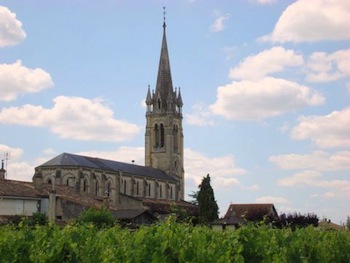 It felt like live adult entertainment as we observed a delivery truck driver and a female worker from the Pomerol Church complex grope at each other between two vehicles, as if auditioning for pornographic film roles. They were aware of our presence, and it made no difference. Did we turn our heads, like gentlemen? Nahhh. After our sandwiches were consumed and the matinee of “Rue de l’Eglise” had concluded, we drove over to the building we thought was our next stop, Chateau Clinet. However, the large Clinet sign in the neighboring vineyard was only indicating the vineyard belonged to that winery. Dave and Bob decided to take a walk, since again we were early. They spotted a signboard which properly conveyed the location of the Chateau, so we drove the short distance to our proper destination.
It felt like live adult entertainment as we observed a delivery truck driver and a female worker from the Pomerol Church complex grope at each other between two vehicles, as if auditioning for pornographic film roles. They were aware of our presence, and it made no difference. Did we turn our heads, like gentlemen? Nahhh. After our sandwiches were consumed and the matinee of “Rue de l’Eglise” had concluded, we drove over to the building we thought was our next stop, Chateau Clinet. However, the large Clinet sign in the neighboring vineyard was only indicating the vineyard belonged to that winery. Dave and Bob decided to take a walk, since again we were early. They spotted a signboard which properly conveyed the location of the Chateau, so we drove the short distance to our proper destination.
In early January, when I first contacted their director of Marketing and Communications, Denise van der Meer, she agreed to our afternoon appointment time. Later in our communications, she realized that there was a luncheon scheduled at the winery with a group of German buyers, which could not be moved. Since she spoke German (among many other languages), she was to be their host. I was nervous that we might be displaced, being the weaker link, but Denise maneuvered a way to handle both obligations. She proved herself most industrious that day.
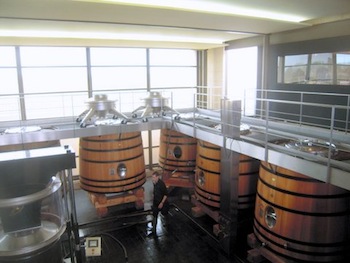 The Chateau was a relatively small structure, sandwiched in between newer production/storage type buildings, which created a visual effect of a long rectangular facility bordering the “Chemin de Feytit” roadway. Efficiency was key to this large scale operation, in such tight quarters. Noticing that the reception area was packed with dining dignitaries, we moved along to the newest building where grapes were crushed and wine fermented. Denise had spotted us wandering about outside and met us inside the vat room. She apologized again for having to deal with her other guests, and asked if we wished for another person to show us around. She was a bright ray of sunshine, so of course we opted to wait a few more minutes for her to be our host.
The Chateau was a relatively small structure, sandwiched in between newer production/storage type buildings, which created a visual effect of a long rectangular facility bordering the “Chemin de Feytit” roadway. Efficiency was key to this large scale operation, in such tight quarters. Noticing that the reception area was packed with dining dignitaries, we moved along to the newest building where grapes were crushed and wine fermented. Denise had spotted us wandering about outside and met us inside the vat room. She apologized again for having to deal with her other guests, and asked if we wished for another person to show us around. She was a bright ray of sunshine, so of course we opted to wait a few more minutes for her to be our host.
There was very little delay at all as she offered desert wine to her luncheon guests. She left them sipping and returned for the commencement of our tour. Denise informed us that in the 19th century the property belonged to the Arnaud family, then owners of Chateau Petrus. By 1998, Jean-Louis Laborde acquired the vineyard and returned to old farming practices of utilizing horses to minimize tractor compaction of the soils around the vines’ root systems. Replanting began with minimalization of herbicides emphasized. Traditional wooden vats were installed in the modern basement level fermentation room. High quality has been sought over efficiency in the grape sorting, fermentation and aging processes. This has resulted in a more consistently high rated product each vintage year. New ideas, such as experimenting with Austrian oak barrels, are embraced.
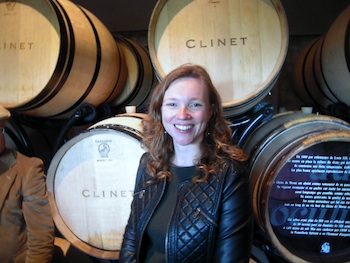 Next we were escorted to the storage area. Barrels were stacked high on modern steel and rubber racks (as utilized at Ch. Lascombes), due to the limitation of space in the facility. Here we were offered to barrel sample the 2012 vintage. The wine was dense in color, offering coco, black cherry and a distinct minerality. For a weak vintage year, this one should excel among its peers. We were then allowed to experience the 2010 vintage (a beauty), which offered a nose of dark fruit and spice, with powerful flavors of dark berry, coffee and similar minerals. Our tasting station was very near the area where the luncheon had concluded. The guests were departing, so Denise suggested that we enter the room and see if there was any remaining desert wine to enjoy. An opened bottle remained, so we were treated to glasses of Hungarian Tokaji Aszu. Although created from grapes subjected to “noble rot,” similar to Yquem, the flavor reminded me of caramelized vanilla/apricot/mango liquor. Twas tasty, but a little went a very long way.
Next we were escorted to the storage area. Barrels were stacked high on modern steel and rubber racks (as utilized at Ch. Lascombes), due to the limitation of space in the facility. Here we were offered to barrel sample the 2012 vintage. The wine was dense in color, offering coco, black cherry and a distinct minerality. For a weak vintage year, this one should excel among its peers. We were then allowed to experience the 2010 vintage (a beauty), which offered a nose of dark fruit and spice, with powerful flavors of dark berry, coffee and similar minerals. Our tasting station was very near the area where the luncheon had concluded. The guests were departing, so Denise suggested that we enter the room and see if there was any remaining desert wine to enjoy. An opened bottle remained, so we were treated to glasses of Hungarian Tokaji Aszu. Although created from grapes subjected to “noble rot,” similar to Yquem, the flavor reminded me of caramelized vanilla/apricot/mango liquor. Twas tasty, but a little went a very long way.
We sat and talked with Denise for quite a while before departing. She shared her education, list of fluent languages and working history before commencing her employment at Clinet. For a lady so young, she had quite a resume. And more impressive was her positive attitude and marketing acumen, which greatly benefits her employer. We were all impressed and pleased to have made her acquaintance.
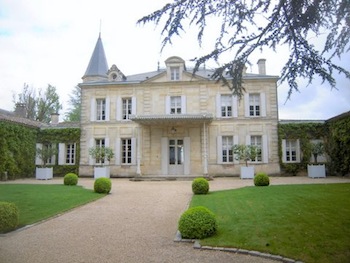 Our final stop of the day was on the western perimeter of St. Emilion, only a two-lane street width away from Pomerol, Chateau Cheval Blanc. Two years back, I had been turned away from this winery due to their not-yet-complete construction of a bold white domed expansion facility. At the time it was the talk of the locals, appearing as a space-aged design, improperly placed in this realm of traditional Chateau structures. It was still not lovingly embraced, just quietly accepted as if a brash cousin that one is forced by bloodline to tolerate. This year, I had tussled with my contact, Stéphanie Duhar, attempting to secure the visit. I finally changed our schedule for the Right Bank, to accommodate her availability. She relented.
Our final stop of the day was on the western perimeter of St. Emilion, only a two-lane street width away from Pomerol, Chateau Cheval Blanc. Two years back, I had been turned away from this winery due to their not-yet-complete construction of a bold white domed expansion facility. At the time it was the talk of the locals, appearing as a space-aged design, improperly placed in this realm of traditional Chateau structures. It was still not lovingly embraced, just quietly accepted as if a brash cousin that one is forced by bloodline to tolerate. This year, I had tussled with my contact, Stéphanie Duhar, attempting to secure the visit. I finally changed our schedule for the Right Bank, to accommodate her availability. She relented.
We had wondered how to access the facility, since the main driveway was still being refurbished. Denise called for us, before our departure at Clinet, and informed me of the alternative route, via a dirt road entrance directly across the street from L’Evangile. The drive to the property was a quiet victory for me. We met Stéphanie outside the visitor’s entrance. She was very accommodating, as if our jousting had only been an amusing test of my endurance. She began by explaining the history of the property.
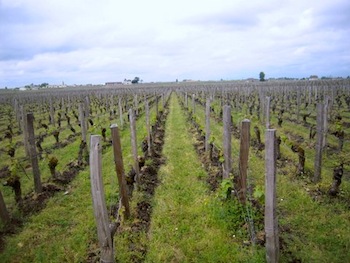 The estate had been conceived in 1834, after the owner of Chateau Figeac sold 15 hectares of their vineyard to the Laussac-Fourcaud family. Over the years the holdings expanded to 39 hectares under vine. Interestingly, following Robert Parker’s low rating of the 1981 vintage, the winery’s manager asked Parker to return for a retaste. Upon his arrival, the manager’s dog attacked Parker as he stood idly by and watched. When Parker asked for a bandage to stop the bleeding, he was offered only a copy of the offending rating report. Parker did retaste the vintage, with only a modest upward score. The property remained in the family until 1998, when it was sold to the corporate conglomerate LVMH, owner of Louis Vuitton and Moët & Chandon. Currently the vineyards yield 60% Cabernet Franc and 40% Merlot grapes.
The estate had been conceived in 1834, after the owner of Chateau Figeac sold 15 hectares of their vineyard to the Laussac-Fourcaud family. Over the years the holdings expanded to 39 hectares under vine. Interestingly, following Robert Parker’s low rating of the 1981 vintage, the winery’s manager asked Parker to return for a retaste. Upon his arrival, the manager’s dog attacked Parker as he stood idly by and watched. When Parker asked for a bandage to stop the bleeding, he was offered only a copy of the offending rating report. Parker did retaste the vintage, with only a modest upward score. The property remained in the family until 1998, when it was sold to the corporate conglomerate LVMH, owner of Louis Vuitton and Moët & Chandon. Currently the vineyards yield 60% Cabernet Franc and 40% Merlot grapes.
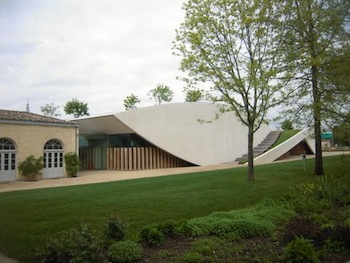 We immediately proceeded to the new addition. It houses the executive offices, winemaking and wine storage in an eco-friendly dome, which if built in the USA would be at least rated “LEED Gold.” There were rows of impressive concrete fermenting vats, illuminated by fluorescent lights and skylights from the roof structure above. Barrel storage was located in adjoining chambers, requiring air conditioning for cooling and humidity control. Barrel storage of the wine was with 100% new oak for 18 months. Cooperage is subcontracted.
We immediately proceeded to the new addition. It houses the executive offices, winemaking and wine storage in an eco-friendly dome, which if built in the USA would be at least rated “LEED Gold.” There were rows of impressive concrete fermenting vats, illuminated by fluorescent lights and skylights from the roof structure above. Barrel storage was located in adjoining chambers, requiring air conditioning for cooling and humidity control. Barrel storage of the wine was with 100% new oak for 18 months. Cooperage is subcontracted.
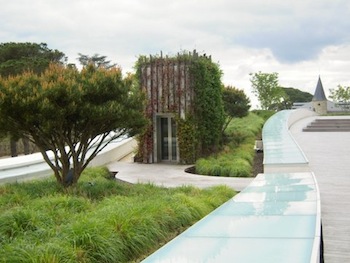 Next, we were led to a stairway which took us to the roof of the facility. This is where we could see the efforts to provide natural climate control of the building with strips of trees and grasses planted in beds as biologic receivers of rainwater and buffers of atmospheric conditions outside. A wooden walkway allowed access to various sections of the roof’s structure, offering views of Pomerol and St. Emilion as if atop a lone hill. I would agree with the neighbors that this architecture exhibited a lack of respect for its historic surroundings, yet it could not be argued that the facility was ecologically and structurally impressive.
Next, we were led to a stairway which took us to the roof of the facility. This is where we could see the efforts to provide natural climate control of the building with strips of trees and grasses planted in beds as biologic receivers of rainwater and buffers of atmospheric conditions outside. A wooden walkway allowed access to various sections of the roof’s structure, offering views of Pomerol and St. Emilion as if atop a lone hill. I would agree with the neighbors that this architecture exhibited a lack of respect for its historic surroundings, yet it could not be argued that the facility was ecologically and structurally impressive.
We returned to the first floor, where a table had been set up in the center breezeway for tasting. Samples of the 2006 Cheval Blanc wine were offered. My impression of the nose was spicy dark fruit and caramel. Tannins were sweet and soft for this relatively young vintage. I felt it ready to consume, and I did not spit. Stéphanie then informed us she had to leave us for a company birthday party as we noticed employees wandering toward the new building for the event.
With another fine day of wine adventures in Bordeaux concluded, we returned homeward where reliable Christophe was in the kitchen cooking the evening’s delightful fare. Accessing my computer, I received a message from the elusive Marie Guillard of Chateau Margaux. In her last email to me before our journey, her English usage seemed to indicate she would not meet us late Thursday evening as I had requested in my final desperate attempt to gain acceptance. My response was polite, but expressing disappointment. That evening’s note cleared the misunderstanding as she insisted that she would indeed meet us. Fist-Bump!! We were blessed with the First Growth visit that I had sought since the first day I started writing her emails in January. I informed the boys as we sat down to our dinner. Life was good!
Chateau Clinet
www.chateauclinet.com
Chateau Cheval Blan
www.chateau-cheval-blanc.com
LEED--Leadership in Energy and Environmental Design http://www.usgbc.org/leed
LVMH
www.lvmh.com
Chateau Margaux
www.chateau-margaux.com/en
Note: This information was accurate when it was published. Please be sure to confirm all rates and details directly with the businesses in question before making your plans.



